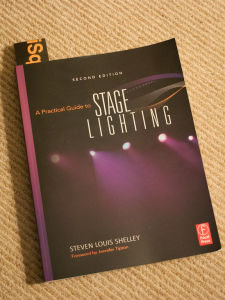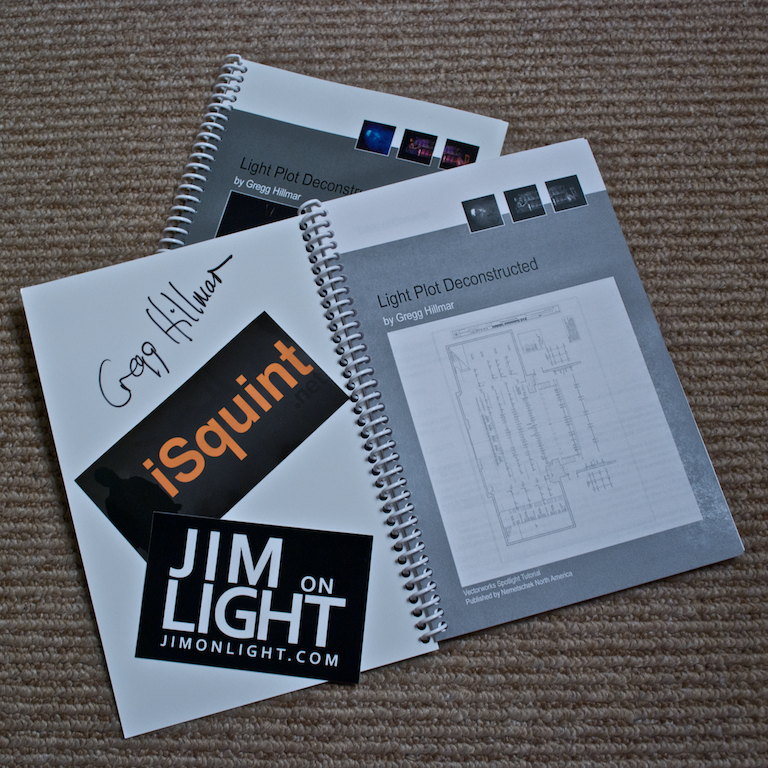Review: A Practical Guide to Stage Lighting, Second Edition
 Towards the end of 2009, Steve Shelley, noted lighting designer and drafting template guru, released the second edition to his book, A Practical Guide to Stage Lighting (published by Focal Press). Soon after the release of Mr. Shelley’s book, Focal Press was kind enough to send me a copy of the book to review.
Towards the end of 2009, Steve Shelley, noted lighting designer and drafting template guru, released the second edition to his book, A Practical Guide to Stage Lighting (published by Focal Press). Soon after the release of Mr. Shelley’s book, Focal Press was kind enough to send me a copy of the book to review.
Hands down this is a great book. I’ve personally met Mr. Shelley and he always has a smile on his face and a good story to tell, along with his trademark “lime green cap.” Though his vast lighting expertise is apparent, Mr. Shelley carries his wonderful sense of humor and storytelling throughout, making this edition both entertaining—and educational.
Layout of the Book
As an aspiring lighting designer, have you ever wondered what it’s like to design a Broadway-style show? Imagine being able to look over the shoulder of a professional lighting designer to see how he accomplishes his vision and design from start to finish. That is how Mr. Shelley has written the book. He first starts off with the basics of lighting: covering the layout of a theatre, stage directions, electricity, lighting instruments, and production staff. Why start there? The book assumes that this is your first venture into lighting and gives a quick overview of these topics to help you understand their use and role later on in the book.
After that, it’s all business. Beginning with the research of the show, first production meetings, organizing your paperwork, and of course, starting the design process—getting to “the hang,” focus, previews, opening night and finally, archiving all of your work. Mr. Shelley goes into great detail about each step of the process and provides some great insight and advice along the way with sidebars “Shelley’s Soapbox,” “Tales from the Road,” along with other helpful tidbits like “Shelley’s Notes,” “Sneaky Tips,” and my favorite, “Shelley’s Golden Rule.”and particularly in the “Shelley’s Soapbox” and “Tales from the Road” sidebars. Together, they give the readers a first hand glimpse into the real world of stage lighting.
Throughout the book, Mr. Shelley provides examples of his paperwork and drafting style to help the reader understand the subject matter at hand. This being the second edition of the book, Mr. Shelley has included over 60 new topics ranging from creating and negotiating contracts to working with other designers and production staff members through out the design process.
Targeted Audience
Mr. Shelley has packed his book with information and advice that anyone in the entertainment industry could use. But who did he write to book for? I believe that any aspiring lighting designer or technician will find this book quite useful. The book is not only a guide to help layout and design a show but it’s also a quick technical reference tool. Mr. Shelley mentions in the the introduction of the book that he himself uses his book time and time again to help remember important steps and processes in order to deliver a cost-effective, timely, and dazzling lighting design. Seasoned lighting design veterans can relate and use the book just as Mr. Shelley does. And, not only to help remember processes but to learn new and different methods as well.
Conclusion
For $49.95 from Focal Press’s website, (www.focalpress.com), Mr. Shelley’s latest edition of A Practical Guide to Stage Lighting is a must-read for new or up-and-coming lighting designers and technicians. Seasoned lighting designers will find Mr. Shelley’s book quite useful, as well, for learning different methods or refining their own design methods.
Thank you Mr. Shelley and Focal Press for providing me with a copy of A Practical Guide to Stage Lighting for this review.
[nggallery id=27]
Where is the Industry Heading – An Interview with Steve Shelley
This months Where is the Industry Heading Column is an interview with noted Lighting Designer and drafting symbol guru, Steven Shelley. In addition to Mr. Shelley’s design talents and drafting template genius, he has also found time to write a book for the lighting industry, A Practical Guide to Stage Lighting which just recently went into it’s second edition. Look for a review of Mr. Shelley’s latest book here on iSquint very shortly.
In regards to paperwork, how has that changed from when you started to where you are now?
Night and day. When I started it was legal pads and lots of mistakes. Copies were photocopies at best, or mimeographs. When I started at American Ballet Theatre, we used the new Macintosh computer and the application “Multiplan” to re-sort the paperwork.
What are your thoughts on LED’s in general for use within the industry?
Eventually they will pull even until the next source takes them over. Right now they are still pretty expensive. Yes, you get a great long-term bang for your buck, but for short rentals, they are still more in the “eye candy” genre as far as I can tell.
What challenges do you face with the ever changing console architecture?
It’s not easy to catch up. With all the different variations and new approaches, it seems that having a console operator fluent in the specific console is now more critical than ever before. While this is the nature of the beast on moving light consoles, it’s now becoming more prevalent on consoles solely utilizing conventional fixtures as well. While I can appreciate that, there are times of frustration when I can no longer figure out how to merely turn a fixture on. And neither can the newbie console operator.
Does 3D rendering provide a reliable method for developing a concept while designing out a production?
It may do so to illustrate a concept for a client. Otherwise I find it more time consuming than mentally producing the 3D rendering with mental images translated to my own notes and the light plot.
Do you feel that projection media is a form of lighting or should it be considered a separate field?
I think projection media is a form of scenography, and as such, a separate field. I have nothing but respect for projection specialists and, in the heat of a production period, I’m thrilled they are there to help collaborate on the piece, and assume the responsibility for the creation of that facet of the visual look for the show.
Looking back at a past production, how would you change it with some of the latest technology out on the market today?
In most cases, I would consider changing stuff on previous shows if it reduced the amount of power, cost, gear, load-in time, or replication time. In some cases that might be as simple as color changers; on other shows that might be replacement of specials with fewer lights and programmable mirrors. There are a few shows that I would consider swapping out gear for movers, but to do so would then potentially result in the need for more time to re-program the replacement units. In my experience, making these kind of changes must be carefully considered within the big picture, rather than as a quick-fix “knee-jerk” reaction.
What new or upcoming technology has the potential to change the lighting industry?
Right now it seems to be the light sources. No doubt, though, it will be something completely different than what anyone can postulate today.
What advice can you give to a beginner looking to make it in the industry?
Be polite. Smile. If you don’t have a passion for this, get out. Don’t hesitate to ask questions when you need to. Don’t feel like you deserve something; you will have to work for it.
Do you have any tech-table rituals or traditions?
Define the location of the tech table as soon as you walk in the door. Then they can be set up without waiting for your placement instructions. Always have a trash can to distinguish from archives. Pack up your stuff before the final tech; you don’t know how quickly the tables will need to be struck after the end of the rehearsal.
What is your favorite gel color and why?
Gam 850 among many many others. I like blue.
More about Steve Shelley
 Steve Shelley is a freelance lighting designer. He’s also the designer of the Field Template series of plastic drafting stencils, the Vectorworks toolkit SoftSymbols, and the author of “A Practical Guide to Stage Lighting, Second Edition” published by Focal Press. He lives in New York City.
Steve Shelley is a freelance lighting designer. He’s also the designer of the Field Template series of plastic drafting stencils, the Vectorworks toolkit SoftSymbols, and the author of “A Practical Guide to Stage Lighting, Second Edition” published by Focal Press. He lives in New York City.
You can find Mr. Shelley at most trade shows and conferences wearing the lime green cap, a smile and key chain versions of his popular Field Templates. You can find more information about Mr. Shelley and his templates at www.fieldtemplate.com.
Light Plot Deconstructed Contest Part 2 on Jimonlight

iSquint and Jimonlight.com have been running a contest during the month of October in two parts for Gregg Hillmar’s latest book, Light Plot Deconstructed. The first part of the contest was held here on iSquint and the second part on jimonlight.com. Jimonlight’s part of the contest stops tomorrow, Friday October 30 at midnight. You still have time to enter the contest by leaving a comment on Jimonlight’s contest page. All you have to do is leave your name, email address, (which is not published) and a note.
Jim will be announcing the winner after the contest is over. Learn more about Light Plot Deconstructed by reading our review here on iSquint. If you don’t win, you can pick up a copy of Gregg’s book at his website, www.lightplotdeconstructed.com.
Trivia Contest Over in Record Time
 We ran a trivia contest last week to win a copy of Richard Cadena’s latest book, Electricity for the Entertainment Electrician & Technician. The winning answer was posted in record time of 18 hours after the contest began. Tom Baldwin of Hampshire (UK) had the winning answer with a detailed explanation of why.
We ran a trivia contest last week to win a copy of Richard Cadena’s latest book, Electricity for the Entertainment Electrician & Technician. The winning answer was posted in record time of 18 hours after the contest began. Tom Baldwin of Hampshire (UK) had the winning answer with a detailed explanation of why.
The resistance of a lamp varies with temperature.
So it’s not as simple as using Ohm’s law to work out the resistance from 575W @ 115V and recalculate for 120V.
On a 120V supply, the lamp will burn hotter, and so its resistance will be lower. This means that the current flowing will be greater than the naive calculation assumes.
In practise, the easiest way to determine the current at 120V would be to simply measure it.
To predict the current, it would be necessary to measure the operating current at a number of voltages, and to plot a curve of filament resistance versus applied voltage. From this curve the operating current at any given voltage could be extrapolated (or interpolated).
By using a mathematical fitting function to map the measured points on the graph back to a mathematical function, this prediction could be made without recourse to graph paper.
There are, of course, ready reckoning tables, which would allow the current change for x% increase to be roughly estimated.
And after all that writing, the real answer is that there can be very few circumstances where the change in operating current between 115V and 120V really matter!
We congratulate Mr. Baldwin on a job well done! To purchase your copy of the book, visit the PLSN Bookshelf at www.plsnbookshelf.com
LatestHeadlines
- Upgrading Your Toolbox: City Theatrical DMXcat-E and DMXcat Multi Function Test Tool
- Claypaky Bringing Back the Sexy to Par Cans with the Midi-B FX
- Ayrton Evolves the Cobra, the Cobra2 Developed for the US Market
- MA Lighting Intros grandMA3 onPC Fader Wing and DIN-Rail Nodes
- Live Events LEVL Up Fest: A Festival to Aid our Industry